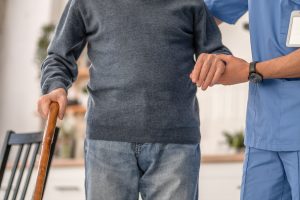By Vanessa Carmody OTD, OTR/L,CAPS
Falls and Parkinson’s Disease
Fall prevention is often misunderstood as just decluttering and removing throw rugs. However, it’s more than that. Falls are prevalent, and to prevent them, one needs to comprehend the multifaceted list of factors that cause them and the possible solutions.
The Issue and Risk
Primary reasons for these falls include body generalized weakness; vitamin D deficiency and other nutritional deficits; side effects from certain medications such as antidepressants and/ sedatives; vision problems (particularly those related to peripheral vision); foot pain and/or poor footwear; and environmental hazards such as clutter and, yes, throw rugs. Most falls are caused by a combination of these different risk factors.
There are additional specific risk factors for individuals with Parkinson’s Disease. These include slowed reaction time (postural response strategies are slowed and are smaller); freezing and/or slowing of gate; dizziness from autonomic and/or vestibular issues and postural hypertension; shortened and variable step length; dual-task difficulties or difficulties doing more than one thingat once; balance difficulties related to axial rigidity and flexed posture; and difficulties with quick changes in the use of muscle groups opposite of each other for controlling posture.
Other factors that can play a part in increased fall risk in those with Parkinson’s disease include dyskinesias, fatigue, insomnia, and increased postural sway. Normally, our center of gravity is just below the naval and in the middle of our base of support. The center of gravity often travels outside of the base of support in an individual with Parkinson’s Disease.
In addition, being afraid of falling can actually make you more likely to fall. Fear puts stress on your body and can worsen symptoms of Parkinson’s disease, increasing the risk of falling. Fear can also cause you to avoid activities or ask for more help, leading to less practice and decreased efficiency in performing those skills. When we are afraid, we may also override our body’s natural posture reactions, which can be especially problematic for individuals with Parkinson’s disease. Even though these postural reactions may be slowed in those with Parkinson’s, they are still present. Increased fear can cause us to fight against these natural reactions, making us more likely to fall.
Balance is not simple and depends on many factors. These factors include:
- How well your legs and back can move
- How stable you are when leaning or reaching without stepping
- Your ability to plan and control your movements before you make them
- How quickly you can react and recover if you lose your balance
- How well your brain can use information from your senses (like vision and body position) to understand how your body is moving
- Your ability to walk and do other activities at the same time.
Effective Solutions
So, what can be done? First, screening is one of the best ways to understand your risk of falling and address issues early. See a doctor regularly and have your eyes and medication list examinedoften. Talk about both motor and non-motor symptoms such as sleep disturbances, fatigue incontinence, and blood pressure issues. Participate in balance screenings. Oftentimes, these are completed at familiar community sites including senior centers and community nonprofits such as Parkinson Place. A balance screening includes an assessment of overall balance and the potential underlying factors that could be addressed through physical therapy and/or occupational therapy. These services are offered on an outpatient basis and can be covered by Medicare and common insurance. Skilled therapists, professional exercise classes, and personal trainers can use training techniques to help improve your balance and decrease your risk of falling.
As we age, our systems for feedback and control get weaker naturally. With Parkinson’s disease, systems generally operate more inconsistently. There are several methods for addressing balance deficits with the intention of preventing falls. Physical and occupational therapists, along with community-based skilled programs, can employ several methods to directly address fall prevention.
Vanessa Carmody, OTD, OTR/L, CAPS is an academic professor with specialized expertise in community-based programming, research, and education for people with neurodegenerative conditions. She is a board-certified occupational therapist and a certified aging-in-place specialist.



